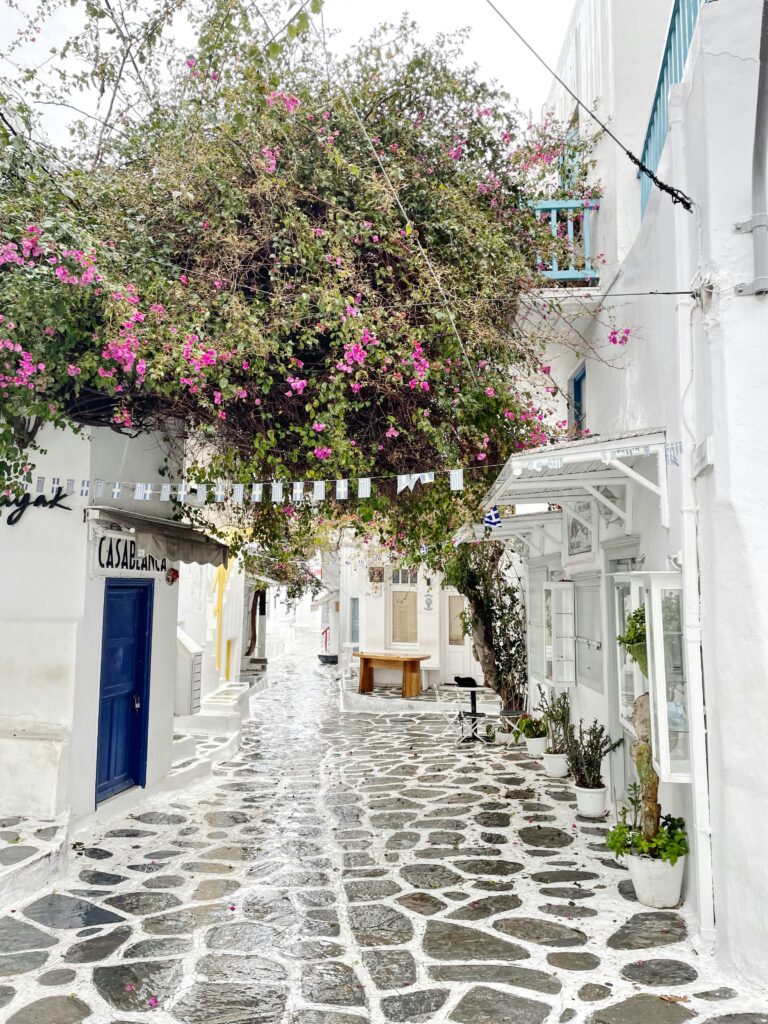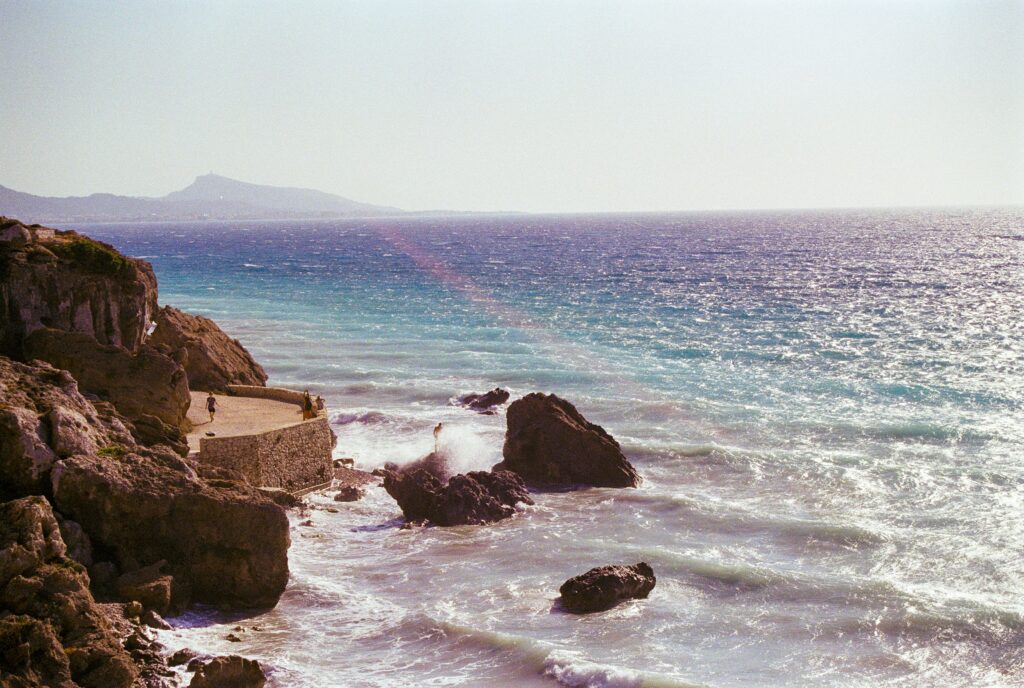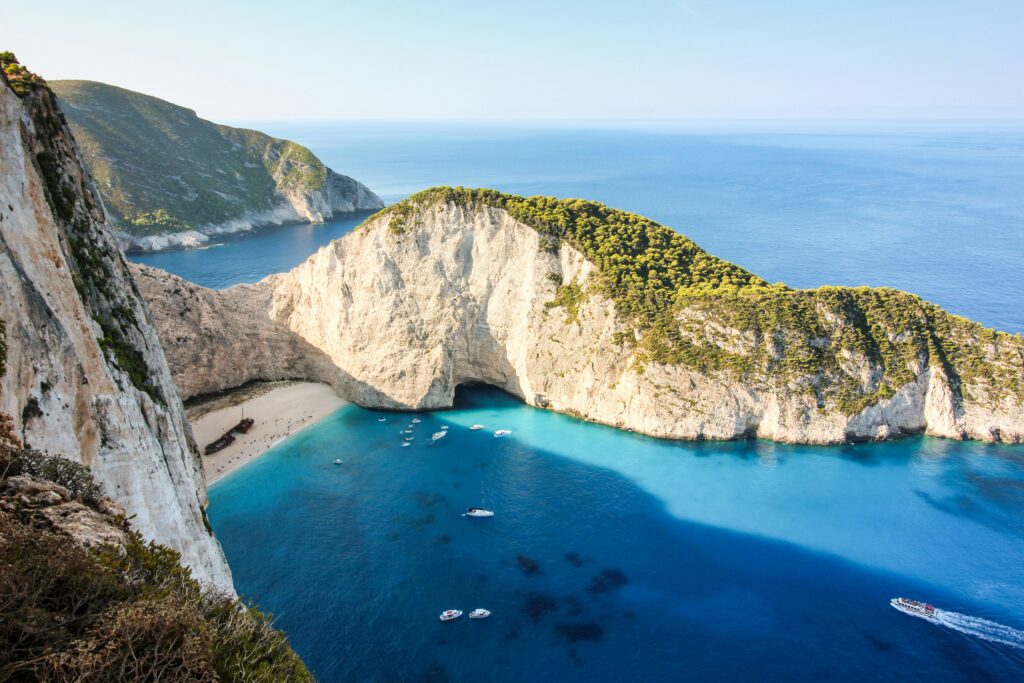If the Cycladic islands have a bohemian heart, it beats strongest on Paros and Naxos. These sister islands—separated by a narrow channel crossed by frequent ferries—occupy a sweet spot in the Greek island landscape. They offer the classic Cycladic aesthetic of whitewashed villages and blue-domed churches, the beaches and crystal waters that draw people to the Aegean, and enough infrastructure to ensure comfort, yet they’ve remained largely free of the overwhelming tourism that’s transformed Santorini and Mykonos into international destinations. What you find instead are islands that retain authentic Greek character while welcoming travelers who seek substance over spectacle.

Paros and Naxos are larger than they appear on maps—substantial enough to contain multiple distinct regions, varied landscapes, and the sense that there’s always another beach to discover, another village to explore, another valley to hike. They’re islands where agriculture still matters, where fishing remains an actual livelihood rather than tourist performance, where elderly women still dress in black and sit in doorways greeting neighbors, where the rhythm of life follows seasons and traditions that long predate tourism.
For yoga practitioners looking for a retreat in Greece, these islands offer environments that feel genuinely restorative rather than merely pretty. The pace here is profoundly unhurried—not because anyone’s trying to create a retreat atmosphere but because that’s simply how life moves on islands where the wind dictates schedules and patience is a survival skill. Retreat centers tend toward the small-scale, family-run, and authentically integrated with local communities. You’re more likely to practice in a converted farmhouse surrounded by vegetable gardens than in a purpose-built wellness resort, more likely to eat with your hosts than be served by staff, more likely to be invited to a village festival than isolated in a retreat bubble.

Paros: Wind, Water, and Wanderers
Paros sits almost exactly in the center of the Cyclades, which has made it a transportation hub since ancient times. The island’s central port, Parikia, buzzes with ferry traffic year-round, creating an energy that’s lively without being chaotic. But step away from the port area, and Paros reveals quieter faces—hillside villages like Lefkes and Marpissa built to escape pirate raids, valley farmland producing wine and vegetables, and coastlines ranging from sandy family beaches to rocky promontories where only determined swimmers venture.
What defines Paros most distinctly is wind. The Meltemi that sweeps across the Cyclades each summer finds particular favor here, creating conditions beloved by windsurfers and kitesurfers who flock to beaches like Golden Beach and New Golden Beach. This same wind shapes yoga practice on Paros—you learn quickly to find your foundation more precisely, to engage your core more actively, to accept that some days outdoor practice simply won’t work and flexibility matters more than adherence to plans.
The island’s yoga retreat scene reflects its bohemian, sporty character. You’ll find retreats that combine yoga with windsurfing or kitesurfing, programs emphasizing active outdoor practice alongside more traditional sessions, and accommodations ranging from simple rooms in traditional houses to more polished boutique properties. What they share is a certain unpretentiousness, an understanding that yoga practice here is part of a larger engagement with the elements—wind, water, sun, salt—rather than something separate from daily island life.

Paros also benefits from excellent ferry connections to neighboring islands, making it easy to combine destinations or extend your stay with island-hopping. Antiparos, a smaller island just offshore with its famous cave and laid-back atmosphere, makes an easy day trip. Naxos is 45 minutes away by ferry. Even Santorini and Mykonos are accessible for those who want to experience multiple island types during one Greek visit.
Naxos: Green, Grounded, and Generous
Naxos is the largest Cycladic island and the most agriculturally productive, which immediately sets it apart from its more barren neighbors. The island’s interior is green—not tropical lushness but the silvery green of olive groves, the darker green of citrus orchards, the varied greens of vegetable plots and vineyards. Mountains rise high enough to capture moisture, creating springs that feed valleys where traditional agriculture continues to thrive. This is the island that supplies other Cyclades with produce, cheese, and the famous Naxos potatoes that Greeks insist taste different (and better) than all others.
This agricultural abundance translates directly into retreat experiences. Food on Naxos isn’t just good—it’s exceptional in its freshness, variety, and the sense that every ingredient is expressing its fullest potential. The local cheese, particularly graviera and arseniko, is legendary. The vegetables taste like concentrated versions of what you find in supermarkets elsewhere. Even simple meals become memorable when ingredients are this vital and alive.
Naxos also offers more dramatic landscape variation than most Cycladic islands. The western coast features long sandy beaches ideal for families—and for morning beach yoga sessions. The eastern and southern coasts are wilder, with dramatic rock formations, secluded coves, and water in impossible shades of turquoise. The mountainous interior, particularly around the village of Apiranthos, feels almost alpine in character, with stone houses built from local marble and mountain paths leading to Byzantine churches and ancient ruins.
Yoga retreats on Naxos range from beach-based properties where you practice with toes in sand, to mountain renovations where you wake to goat bells and practice with views across valleys, to small hotels in port towns where you can combine retreat time with easy access to restaurants, shops, and the social energy of a working harbor. The common thread is a certain groundedness—Naxos retreats feel rooted in place rather than floating in wellness tourism abstraction.
Retreat Styles: Small-Scale and Authentic
What distinguishes yoga retreats on Paros and Naxos from more famous islands is scale and ownership. You’re unlikely to find large wellness resorts or international yoga brands here. Instead, the retreat landscape consists of small operations—converted farmhouses accommodating 6-10 guests, family-run guesthouses that host one group at a time, beach properties with a handful of rooms and one yoga instructor living on-site.
This small scale creates intimacy and flexibility. Programs can adapt to group energy and interests. Meals around a shared table foster genuine community. Relationships with hosts become personal rather than transactional. The yoga teacher is often also the cook, the garden tender, and the person who picks you up from the ferry—they’re fully present rather than clocking in for scheduled sessions.
Accommodations emphasize authenticity over luxury. Rooms in traditional Cycladic houses with vaulted ceilings and simple furnishings, shared bathrooms in some cases, outdoor showers surrounded by gardens, basic but comfortable beds, and minimal decoration that lets architecture and landscape provide the aesthetic. The focus is on what matters—good light, comfortable practice spaces, places to gather and eat together, and access to nature.
Many retreat hosts are expats who fell in love with these islands and chose to stay, or Greeks who returned to family properties after careers elsewhere. They bring dedication that exceeds professional hospitality—they genuinely care about the islands, the traditions, the communities, and creating retreat experiences that honor rather than exploit local culture. This shows in countless small ways, from sourcing food locally to hiring Greek teachers and cooks, from participating in village life to ensuring retreats benefit rather than burden island communities.
Daily Rhythm and Practice Style
Retreats on Paros and Naxos tend toward relaxed rather than intensive practice schedules. Morning yoga sessions happen early, before heat and wind build, in outdoor spaces—beach platforms, garden terraces, rooftops with island views. Classes run 90 minutes to two hours and generally emphasize flowing styles (Vinyasa, Hatha flow) that match the island energy—steady, grounded, responsive to conditions.
Afternoons are unstructured. You might windsurf or kitesurf (Paros especially), hike to remote beaches, explore villages, shop at local markets, or simply read and rest. Some programs offer optional workshops or activities—cooking classes, visits to cheese-makers, pottery lessons, guided hikes—but there’s no pressure to fill every hour. The islands themselves provide entertainment enough if you’re willing to wander.
Late afternoon brings another practice, often more restorative than morning sessions, followed by sunset rituals (watching the sun sink into the Aegean becomes a daily meditation) and dinner. Meals are communal, often featuring ingredients from local farmers and fishermen, prepared in styles that honor Greek traditions while accommodating contemporary dietary preferences. Wine flows freely—both islands produce their own—and conversations extend late into evenings because there’s nowhere else to be and no reason to rush.
The overall feel is spacious and unhurried, with yoga practice anchoring days but not dominating them. This appeals to experienced practitioners who don’t need intensive instruction or scheduling, who trust themselves to know what they need each day, and who appreciate retreats that feel like authentic island life rather than wellness vacations.
Beyond Yoga: Island Activities
Both islands offer extensive opportunities for outdoor activity that complements yoga practice. Swimming is a daily given—the water is clear, clean, and ranging from gentle to wild depending on location and wind conditions. Many beaches remain remarkably empty even in summer if you’re willing to walk or drive past the most accessible ones.
Windsurfing and kitesurfing on Paros have developed into world-class sports tourism, with several schools offering instruction and equipment rental. The combination of consistent Meltemi winds, varied beach breaks, and warm water creates ideal learning conditions. Some yoga retreats specifically incorporate these water sports, recognizing the natural complementarity between yoga’s focus on breath and balance and the demands of riding wind and waves.
Hiking on both islands reveals landscapes and views that most tourists never experience. Naxos in particular offers extensive trail networks through the mountainous interior, connecting villages, leading to remote churches and archaeological sites, and providing spectacular panoramas. Paros has shorter but equally rewarding coastal paths and the famous Byzantine road connecting mountain villages. Walking here becomes a form of meditation—the rhythm of footsteps, the sound of wind, the vastness of sea and sky creating natural conditions for quieting the mind.
Cultural activities include visiting archaeological sites (Naxos has several significant ancient temples and the famous Portara gateway), exploring traditional villages where marble-paving and Venetian architecture create extraordinary beauty, and participating in local festivals if your timing aligns. Both islands maintain strong cultural traditions, and visitors who show genuine interest are often welcomed into celebrations, religious festivals, and community events.
Food: Island Bounty
Food deserves special mention because it’s central to the retreat experience on these islands. Both Paros and Naxos maintain active agricultural economies, meaning retreat meals feature ingredients grown, raised, caught, or produced locally. This isn’t farm-to-table as marketing concept but as basic reality.
Naxos is particularly famous for its produce—the potatoes that Greeks prize above all others, tomatoes that taste like concentrated sunshine, arsenal cheese that’s protected designation of origin, and graviera that rivals the best Greek cheeses. Local tavernas serve dishes that haven’t changed in generations—moussaka made by grandmothers, fresh fish grilled simply with lemon and oregano, horta (wild greens) gathered from hillsides, fava made from local split peas.
Paros offers similar quality with slightly different specialties. The island’s goat cheese is excellent, vegetables grown in valley farms are intensely flavored despite summer heat, and seafood from surrounding waters appears on plates within hours of being caught. Traditional dishes like revithada (chickpea stew cooked overnight in wood ovens) and kolokythopita (zucchini pie) showcase the island’s agricultural heritage.
Retreat meals typically happen family-style around shared tables, with multiple courses served over extended periods. The emphasis is on seasonal ingredients, simple preparations that honor flavors, and the social aspects of eating together. Many retreats source directly from farmers they know personally, creating economic relationships that benefit local agriculture while ensuring guests eat extraordinarily well.
Wine from both islands—mostly white from indigenous grapes like Monemvasia—accompanies most dinners. The local approach to wine is unpretentious and generous; it’s meant to be drunk with food and friends, not analyzed or saved. This attitude toward eating and drinking—that pleasure and nourishment aren’t opposed but complementary—becomes one of the retreat’s most valuable teachings.
Best Time to Visit Paros and Naxos
May and June: These months offer ideal conditions—warm temperatures (22-26°C), seas warming to swimmable (20-23°C), wildflowers still blooming, and minimal crowds. The Meltemi hasn’t fully established, so wind is generally moderate. This is excellent time for combining beach activities, hiking, and outdoor yoga without heat or wind challenges. Availability is good and prices moderate. Book 6-8 weeks ahead for popular retreats.
July and August: High summer brings guaranteed sunshine, warm seas (24-26°C), and the full force of the Meltemi. Paros especially experiences strong afternoon winds that make outdoor practice challenging but create perfect conditions for wind sports. Both islands see significant tourism in August, with prices peaking and beaches more crowded. For yoga retreats, early July and late August are preferable to the middle weeks. Despite crowds, both islands are large enough to find quiet spots, and the vibrant summer atmosphere—festivals, outdoor gatherings, extended evenings—has its own appeal.
September and early October: Many consider this the sweet spot—the sea retains summer warmth (22-25°C), winds moderate, crowds thin dramatically after August’s final weekend, and the light achieves that golden autumn quality. Locals relax after summer’s intensity, restaurants and services remain fully operational but less stressed, and there’s a palpable sense of islands returning to themselves. This is excellent time for all activities from beach lounging to mountain hiking. Book in advance as these dates are increasingly popular.
Late October through April: Both islands maintain more winter life than tourist-dependent islands, with ferry service continuing year-round (though reduced frequency) and some accommodations and restaurants staying open. Winter brings variable weather—periods of sunshine alternating with storms, genuinely cool temperatures, and seas too cold for most swimming. A handful of retreats operate in shoulder season (October-November, April) for those seeking solitude and authentic off-season Greece. This isn’t for everyone, but for those drawn to dramatic weather and having islands largely to themselves, it offers unique experiences.
Getting There and Around
Both islands have airports with seasonal service, though ferry remains the most common access. From Athens’ port of Piraeus, ferries reach Paros in 3-4 hours (high-speed) or 4-5 hours (conventional), continuing to Naxos (add 30-45 minutes). The islands are well-connected to each other and to other Cyclades, making them ideal bases for island-hopping.
Most retreat centers arrange port pickup, as public transportation is limited and taxis can be scarce during ferry arrivals when dozens of travelers arrive simultaneously. Having a rental car or scooter provides freedom to explore—both islands reward wandering, with small beaches, mountain villages, and quiet corners accessible only if you have your own transportation. Roads are generally good, though some areas require navigating narrow village streets or unpaved tracks to reach remote locations.
Costs and Practical Considerations
Paros and Naxos offer excellent value compared to more famous Cycladic islands. Week-long retreat packages typically range from €800 to €1,600, depending on accommodation quality, season, and inclusions. Most cover lodging, all meals, daily yoga classes, and some activities. Excluded are usually transportation, alcohol, optional excursions, and any spa treatments.
The emphasis is on authentic experience rather than luxury, meaning accommodations will be comfortable but not fancy, meals will be excellent but not elaborate, and instruction will be personal but not necessarily from internationally famous teachers. What you’re paying for is genuine hospitality, quality food sourced locally, small group sizes, and the kind of retreat experience where you leave feeling like you’ve made friends rather than completed a wellness program.
English is widely spoken in tourism areas and at retreat centers, though less so in villages and countryside. Basic Greek phrases help enormously and are genuinely appreciated. Both islands have maintained strong local cultures and pride in their traditions, and visitors who show respect and interest are welcomed warmly.
Is Paros or Naxos Right for Your Retreat?
These islands are ideal for travelers seeking authentic Greek island experiences without overwhelming tourism, who appreciate active outdoor lifestyles, who value substance over polish, and who enjoy the bohemian, laid-back atmosphere that characterizes both places. They’re perfect for wind and water sports enthusiasts, for people who like to explore and discover rather than have everything organized, and for those who find wellness in adventure and nature immersion as much as in formal practice.
Paros and Naxos appeal to experienced yoga practitioners who don’t need intensive instruction, to couples seeking romantic escapes without Santorini’s crowds and costs, to solo travelers comfortable with small-group dynamics, and to families (Naxos especially has family-friendly beaches and activities). They’re excellent choices for those combining yoga retreat with broader Greek island exploration, given the ferry connections to other Cyclades.
These islands are less ideal for those wanting luxury spa facilities, highly structured wellness programs, or resort-style service. They require flexibility regarding weather (wind especially), accommodation quality, and schedules that may shift based on conditions. They’re also not great choices for people who prefer their yoga retreats insulated from local life or who want to avoid wind sports culture.
But if you’re drawn to places that feel genuine rather than performed, where yoga practice integrates with island rhythms rather than existing apart from them, where the wind teaches you about flexibility and the sea about presence, then Paros and Naxos offer something increasingly valuable—the sense that you’re experiencing real places with real people, not tourist simulations designed for Instagram. The yoga practice becomes richer for being grounded in actual community, actual land, actual lives being lived with integrity and joy. And that groundedness might be the most transformative aspect of all.
More about Yoga and Wellness in Greece
December Yoga Retreats in Greece 2026: Winter Stillness
December Yoga Retreats in Greece 2026: Winter Stillness December embraces the profound stillness of early…
July Yoga Retreats in Greece 2026: Peak Summer Power
July Yoga Retreats in Greece 2026: Peak Summer Power July represents the zenith of summer’s…
August Yoga Retreats in Greece 2026: Summer’s Golden Transition
August Yoga Retreats in Greece 2026: Summer’s Golden Transition August embodies the beautiful transition from…
September Yoga Retreats in Greece 2026: Autumn’s Gentle Arrival
September Yoga Retreats in Greece 2026: Autumn’s Gentle Arrival September marks the graceful transition to…
October Yoga Retreats in Greece 2026: Golden Autumn
October Yoga Retreats in Greece 2026: Golden Autumn October transforms Greece with spectacular golden light,…
November Yoga Retreats in Greece 2026: Quiet Contemplation
November Yoga Retreats in Greece 2026: Quiet Contemplation November reveals Greece’s most contemplative side, offering…






